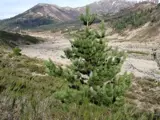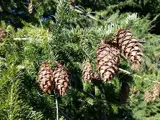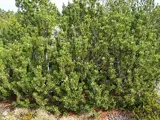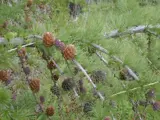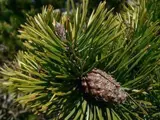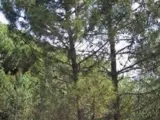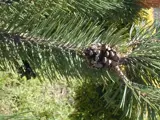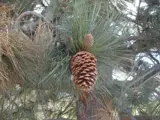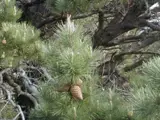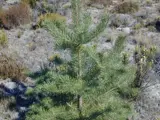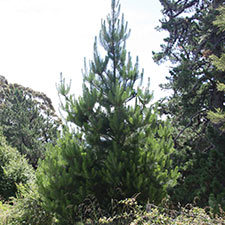 Wilding conifers
Wilding conifers
Common name: Wilding conifers (cedars, pines, firs, cypress, larches, and spruces)
Botanical name: Pinus spp.
Management programme: Sustained Control Rule 5, Progressive Containment
Wilding conifers are introduced conifers that have established naturally because of natural seed spread. Most wilding conifer species originate from North America and Europe and were introduced to New Zealand in the 1880s. Much of the initial wilding conifer spread originated from a range of sources, particularly historic or ‘legacy’ plantings, such as Crown plantings or erosion control plantings.
Why is it a pest?
- Wilding conifers can have significant impacts on native ecosystems, particularly those with low-stature native plants and so can shade out many of these species.
- Wilding conifer infestations can reduce available grazing land and limit future land use options due to the high costs of control.
- Dense wilding conifers can contribute to reductions in surface water flows, potentially impacting on water availability and aquatic ecosystems.
- Dense wilding conifer spread can affect amenity and landscape values and can impede access to, and enjoyment of, recreational areas.
- Wilding conifers can increase the risk posed by wildfires.
Where is it found?
- Risk areas include native forests, clearings, and high country.
- Wilding conifers are spread through wind dispersal, were seeds can be carried long distances by the wind. They are generally sourced back to deliberately planted stands of forestry, shelter belts, or erosion control.
- Wilding pines can be found throughout the Bay of plenty with worst affected areas currently being the upper Rangitāiki, Mt Tarawera, Te Urewera, and East Cape.
What does it look like?
- A conifer is a tree that bears cones and has needle-like or scale-like leaves that are typically evergreen.
- The term Wilding conifer applies to any introduced conifer species when in its wilding form. Ten conifer species are recognised as currently contributing most to the wilding conifer problem in New Zealand these include a range of cedars, pines, firs, cypress, larches, and spruces.
What are the rules?
Wilding conifers are any introduced conifer tree, established by natural means, unless it is being managed as a crop tree within a forest plantation, and does not create any greater risk of wilding conifer spread to adjacent or nearby land than the forest plantation that it is a part of.
For the purposes of this definition, a forest plantation is an area of 1 hectare or more of predominantly planted trees.
The various wilding conifer species present in New Zealand are classified as either Sustained Control or Progressive Containment pests, as outlined in the Wilding Confer Table below:
|
Sustained Control species |
Progressive Containment species |
|
Any introduced conifer tree not listed as a Progressive Containment species. This includes, but is not limited to:
|
|
Sustained Control
Sustained Control pests are well established in the region and preventing the spread is no longer a realistic objective. Management focuses on reducing general impacts of the pest. Landowners/occupiers are responsible for the control of these pest species on their land. Council may enforce control.
Occupiers must destroy wilding conifers if they are either within 200m of any property boundary where the adjoining occupier is also controlling them OR if required by a written direction from an authorised person.
Progressive Containment
Progressive Containment pests are those which the council aims to prevent from spreading, reduce the distribution, or eradicate within parts of the region over time. Landowners or occupiers are responsible for the control of Progressive Containment species on their property. Council may enforce the control of these pest species.
How do you get rid of it?
Recommended:
- Hand pulling
Small seedlings can be hand pulled or dug out.
- Drilling and injecting
Drill holes at a downward angle about 50mm into the trunk.
Fill with neat herbicide.
- Ground basal bark application
An oil-based herbicide designed to penetrate basal bark has been developed and offers advantages over foliar spraying and more labour intensive methods of delivering herbicide internally to the trunk. The herbicide is applied as a wide collar around the trunk.
- Felling
Felling is an effective method of control provided all live foliage is removed from the stump.
If this is not possible because of the terrain, herbicide should be applied to the stump.
Holes should be spaced about 200mm apart around the trunk.
- Aerial spraying - Aerial basal bark application
Helicopters are sometimes used to apply herbicide via a nozzle on a long lance. This method is particularly useful for covering trees spread widely across the high country and can be the only practical way to control trees growing on cliff faces.
CAUTION: When using any herbicide or pesticide, PLEASE READ THE LABEL THOROUGHLY to ensure that all instructions and directions for the purchase, use and storage of the product, are followed and adhered to.
Read more on pest control advice, information and regulations
Images


